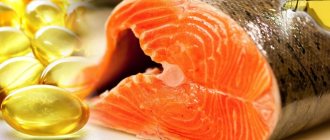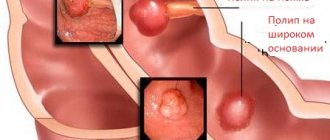pharmachologic effect
After entering the stomach, Gistak suppresses the formation of hydrochloric acid, which affects the pH level (it shifts to the alkaline side).
The activity of the enzyme pepsin, responsible for digesting food, almost completely stops. The effect of the drug lasts about 12 hours.
Remnants of Gistak are eliminated from the gastrointestinal tract very quickly, while food consumption has a slight effect on the degree of absorption of the drug.
When taking tablets orally, the maximum concentration of the active substance in the blood plasma occurs after 2 hours; when using intramuscular injections - after a quarter of an hour. In a healthy body, about 30% of the drug is excreted in the urine.
Method of application, dosage.
For children over 14 years of age and adults – up to 450 mg of the drug per day (150 mg three times a day). If necessary, the daily dose is increased to 650-900 mg.
To prevent relapse of diseases, Gistac is taken daily before bed in an amount of 150 mg. The duration of treatment is calculated individually, taking into account the specifics of the disease.
For intramuscular or intravenous injections - up to 100 mg every eight hours.
Release form
| Release form | |
| Pills | Ampoules for injections |
| 150 mg; 20 and 10 pcs | 50 mg/2 ml; 10 pieces |
| 300 mg; 10 pieces | |
Compound
| Active substances | |
| Pills | Ampoules for injections |
| Ranitidine hydrochloride 167.5 mg Equivalent to ranitidine 150 mg | Ranitidine hydrochloride 56 mg Equivalent to ranitidine 50 mg |
Indications for use
Gistak is used to treat the following diseases:
Ulcers of the stomach and duodenum;- Gastritis of acute and chronic types;
- Gastroduodenitis with high acidity;
- Ulcers arising after operations;
- Esophagitis of various types;
- Gastrointestinal bleeding;
- Dyspepsia of non-ulcer type;
- Zollinger-Ellison syndrome (neoplastic tumors in the pancreas);
- As a prevention of bleeding in patients with peptic ulcers;
- In combination therapy with antibacterial drugs to destroy Helicobacter pylori.
Contraindications
There are no specific contraindications to taking the medicine, except for individual intolerance to ranitidine and age under 12 years.
Use with caution:
- Kidney diseases, renal failure;
- Cirrhosis of the liver;
- Weak immunity;
- Disorders of hemoglobin synthesis (porphyria).
Interaction with other drugs
| Names of substances with which ranitidine is taken simultaneously | Possible reaction |
| Antacids | Decreased absorption of ranitidine |
| Warfarin | Bleeding disorder |
| Bismuth | Increased bismuth absorption |
| Glibenclamide | Hypoglycemia |
| Ketonazole | Decreased absorption of ketonazole |
| Itraconazole | Decreased absorption of itraconazole |
| Procainamide | Reduced renal excretion of procainamide. The consequence is an increase in its concentration in the blood plasma. |
| Phenytoin | Increased concentration of phenytoin in blood plasma. Increased risk of toxicity |
| Cyclosporine | Increased concentration of cyclosporine in the blood |
Histac®
Adults (including seniors)/teens (12 years and older):
The recommended dose is 150 mg twice a day, morning and evening.
Duodenal ulcer, stomach ulcer
: 150 mg twice daily or 300 mg at night, with or without food.
In most cases, ulcer healing occurs within 4 weeks from the start of treatment. In cases of incomplete healing, the ulcer will scar within the next 4 weeks after the initial course of therapy.
Ulcers associated with non-steroidal anti-inflammatory drugs:
an 8-week course of treatment is recommended.
Prevention of ulcers associated with non-steroidal anti-inflammatory drugs:
150 mg twice daily.
For duodenal ulcers, 300 mg twice daily for 4 weeks - ulcers heal faster than 150 mg twice daily or 300 mg at night. Increasing the dose does not lead to an increase in the frequency of adverse reactions.
Duodenal ulcers caused by Helicobacter pylori infection:
Ranitidine is prescribed at a dosage of 300 mg at night or 150 mg twice a day with oral amoxicillin 750 mg three times a day and metronidazole 500 mg three times a day for two weeks.
Treatment with ranitidine should be continued for the next 2 weeks. This treatment option significantly reduces the frequency of relapses of duodenal ulcers. Maintenance therapy with a reduced dose (150 mg at night) is recommended for patients with rapid healing of the ulcer, especially in cases of a history of recurrent ulcers.
Gastroesophageal reflux disease
: The recommended course of treatment is either 150 mg twice daily or 300 mg at night for up to 8 weeks, if necessary up to 12 weeks. In patients with severe esophagitis, ranitidine 150 mg four times a day can be taken for up to 12 weeks. With such an increase in dose, there is no increase in the frequency of undesirable effects.
Zollinger-Ellison syndrome:
The initial dose for Zollinger-Ellison syndrome is 150 mg three times a day, the dose is increased if necessary. Doses up to 6 g per day are well tolerated.
Episodes of dyspepsia:
standard dose is 150 mg twice a day for up to 6 weeks.
Prevention of bleeding from stress ulcers or rebleeding from a bleeding ulcer
: 150 mg twice daily after allowing meals.
Prevention of aspiration before general anesthesia (Mendelssohn syndrome):
Prescribe 150 mg the night before and 150 mg two hours before anesthesia. For women undergoing caesarean section, use 150 mg before surgery, and then 150 mg every 6 hours. At the same time, usual methods of preventing aspiration should be used.
For severe renal failure
with creatinine clearance less than 50 ml/min, the dose of ranitidine is 150 mg at night for 4-8 weeks. The same dose is used for maintenance therapy. If the ulcer does not heal, the dose may be increased to 150 mg twice daily followed by a maintenance dose of 150 mg at night if necessary.
Side effects
In some cases, after taking Gistac, patients may experience the following symptoms:
- Headache;
- Rash on the body;
- Digestive disorders, nausea, diarrhea, constipation, etc.;
- Dryness of the oral mucosa;
- Reduced blood pressure;
- Increased fatigue, irritability, drowsiness;
- Menstrual irregularities;
- Amenorrhea;
- Decreased sexual desire.
Overdose symptoms
Uncontrolled use of the drug may cause seizures and heart rhythm disturbances. For convulsions, intravenous Diazepam is prescribed. In case of cardiac contraction disorders, use lidocaine or atropine.
If chronic renal failure occurs, hemodialysis is prescribed. The essence of the procedure is a therapeutic effect on the organ using an “artificial kidney” device.
Pregnancy and lactation
It is not recommended to take Gistac during pregnancy, except in cases where the benefit to the mother's body outweighs the expected danger to the fetus. Avoid breastfeeding until you finish taking Gistac.
Gistak
Parenterally (i.v., i.m.), orally.
IV slowly (over 5 minutes) 50 mg, diluted with 0.9% NaCl solution or 5% dextrose solution to 20 ml; if necessary, repeat administrations are carried out every 6-8 hours.
IV drip, at a rate of 25 mg/h for 2 hours; if necessary, repeat administration after 6-8 hours.
IM - 50 mg 3-4 times a day.
To prevent bleeding from the upper gastrointestinal tract in patients with stress ulcers, it is preferable to administer a slow intravenous injection at an initial dose of 50 mg, followed by a continuous intravenous infusion of 0.125-0.25 mg/kg/hour. The administration is carried out until the patient is able to eat on his own. Patients with a continuing risk of bleeding are subsequently prescribed orally, 150 mg 2 times a day (as soon as patients begin feeding by mouth).
To prevent the risk of developing Mendelssohn's syndrome - IM or IV slowly, 50 mg 45-60 minutes before general anesthesia or orally, 150 mg 2 hours before general anesthesia and the night before. For women in labor during childbirth - 150 mg every 6 hours.
Children - IV, infusion (over 15-20 minutes), pre-diluted to the required volume with a compatible solution for IV administration, for gastric ulcer - 2-4 mg/kg/day, for gastroesophageal reflux - 2-8 mg/kg 3 times a day.
Inside. Peptic ulcer of the stomach and duodenum (in the acute phase), postoperative ulcers - 150 mg 2 times a day or 300 mg at night for 4-8 weeks. In patients with ulcers that have not healed during this period, continue treatment for the next 4 weeks.
Prevention of relapse - 150 mg at night; for smoking patients - 300 mg at night.
NSAID gastropathy - 150 mg 2 times a day or 300 mg at night for 8-12 weeks; prevention - 150 mg 2 times a day.
Erosive reflux esophagitis - 150 mg 2 times a day or 300 mg at night for 8 weeks; if necessary, the course of treatment is extended to 12 weeks. At II-III stage. severity of reflux esophagitis, the dose is increased to 600 mg/day in 4 doses for 12 weeks. Long-term preventive therapy - 150 mg 2 times a day.
Zollinger-Ellison syndrome - initial dose 150 mg 3 times a day; if necessary - up to 6 g/day.
For chronic episodes of dyspepsia - 150 mg 2 times a day for 6 weeks.
For children for the treatment of peptic ulcers - orally, 2-4 mg/kg 2 times a day; for reflux esophagitis - 2-8 mg/kg 3 times a day; the maximum daily dose is 300 mg.
Patients with impaired renal function require dosage adjustment. For CC less than 50 ml/min with parenteral administration - 50 mg every 18-24 hours; if necessary, the frequency of administration is increased to 2 times a day every 12 hours or more often; when taken orally - 150 mg/day. In the presence of concomitant liver dysfunction, further dose reduction may be required.
For patients undergoing hemodialysis, the next dose of the drug is prescribed immediately after the end of hemodialysis.
List of analogues that the drug Gistak has.
- 1) Rantak.
It is a hypoacid type drug.
- 2) Famotidine.
The drug is an H2-histamine receptor antagonist.
- 3) Nexium.
A widely known antiulcer agent that can reduce the secretion of gastric glands.
- 4) Gastromax.
Blocks H2 receptors due to the content of famotidine and antacids, eliminates the symptoms of heartburn and pain of various types.
- 5) Zantac.
Blocks H2 receptors and is a common antiulcer agent.
Brief instructions for choosing analogue drugs:
- Analogs must have equivalent active ingredients. To find a drug, use the service for selecting analogues by INN.
- The dosage of the analogue should be either the same or less. If the dosage is less, the medication regimen changes.
- The packaging of analogues may differ. Before purchasing, calculate how much of the drug is needed for the course of treatment.
- Analogs must have the same dosage form and route of administration. That is, you should not buy tablets instead of suppositories.
- Keep in mind that not all generic drugs are equally similar to the original drug.
- Do not replace the medicine with a dietary supplement.
Read more below.
Dosage
In the prescription, in addition to the name, the doctor indicates the required dose of the drug. Drugs with the same INN are available in different dosages. The dosage depends on the underlying and concomitant diseases, age, body weight of the patient and other factors.
For example: medications with the active ingredient amoxicillin can be produced in dosages of 125 mg, 250 mg, 500 mg and 1000 mg.
The effect of treatment also depends on the correct dosage. The dosages of analogue drugs should be the same.
If the pharmacy does not have the required dosage, you can recalculate it. By law, this is allowed if the pharmacy has drugs with a lower dosage than prescribed in the prescription. At the same time, the reception regimen will change.
Medicine or dietary supplement
Prescribed medications cannot be replaced with dietary supplements. Dietary supplements do not have a therapeutic effect, but are indicated for use as an additional source of any substances for consumption along with food.
Dietary supplements should not be used as primary treatment. They may contain the same ingredients as medications. However, medicines and dietary supplements undergo different tests for state registration.
When choosing drug analogues, you should pay attention to the name of the drug, namely the active substance. The analogue should be selected taking into account the dosage, course of treatment and dosage form. It is important to pay attention to the manufacturer and whether the chosen product is a medicinal product.
There are contraindications. Possible side effects. Before use, you should consult a specialist.
Release form
When choosing analogues, you need to take into account the amount of the drug per course of treatment. Preparations with the same active ingredient in equal dosages can be produced in different packaging. The doctor writes a prescription, indicating how much medication the patient will need for the entire course of treatment.
For example: paracetamol is available in the form of tablets of 10 pieces, 20 pieces, and the drug Panadol with the same active ingredient is available in 12 tablets.
The doctor also indicates the dosage form of the drug
: tablets, capsules, oral solution, ointment, suppositories (suppositories). Analogs must have the same dosage form and route of administration.
This means that you should not replace tablets with suppositories without consulting your doctor. The method of administration of the drug determines the therapeutic effect, the speed of its onset, as well as the likelihood of developing adverse side reactions. The doctor selects the dosage form taking into account the patient’s characteristics.
For example: the doctor prescribed the drug in the form of rectal suppositories, and you decided to use tablets. Such a replacement may change the speed of onset of the therapeutic effect, since the drug from suppositories reaches the bloodstream faster than from a tablet.
Active substance
Each medicine has several names:
- trade
- international nonproprietary (INN) or grouping, or chemical
Trade name
unique for each manufacturer. It is necessary to distinguish drugs from different manufacturers.
Example of trade names of drugs containing the active substance ibuprofen:
- Dolgit
- Nurofen
- Ibuprofen-Akrikhin
- Faspik
- Mig and others
INN
is the name of the active substance.
An example of an active substance and a preparation containing it:
- ibuprofen (Nurofen, Mig)
- doxycycline (Unidox Solutab, Doxylan)
- acetylsalicylic acid (Aspirin, Upsarin UPSA)
Group name
assigned to a medicinal product if it does not have an INN or several of them.
Examples of group names:
- chondroitin sulfate
- tolperisone + lidocaine
- cod liver oil
Chemical name
- the name of the active substance, reflecting its composition and chemical structure.
The doctor must write a prescription in Latin using the INN. If there is no INN, the prescription is written by generic or chemical name. The drug is prescribed by its trade name if it does not have an INN, generic or chemical name.
The pharmacy employee offers you medications with the active ingredient that the doctor indicated in the prescription. Drugs with the same active ingredient can be produced by different factories. In this case, they will have different trade names.
Analogs must have equivalent active ingredients. To find a drug, use the service for selecting analogues by INN.








